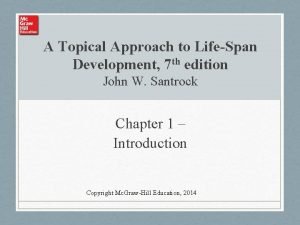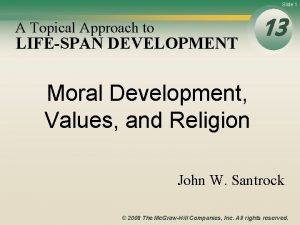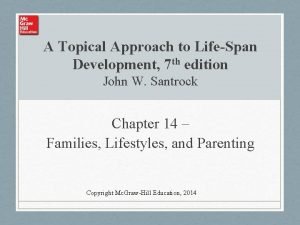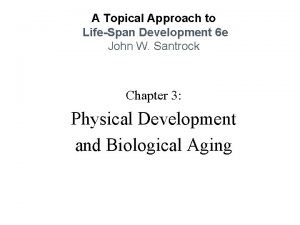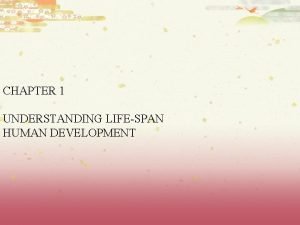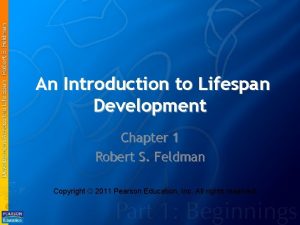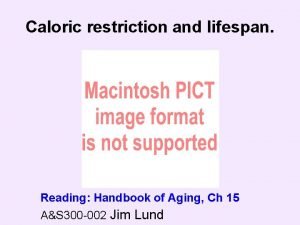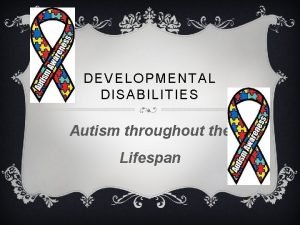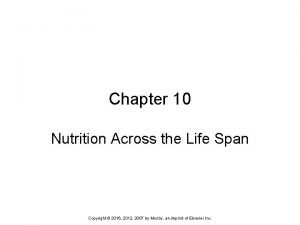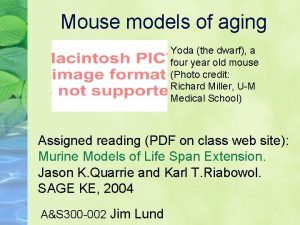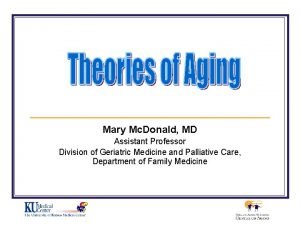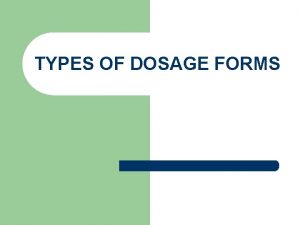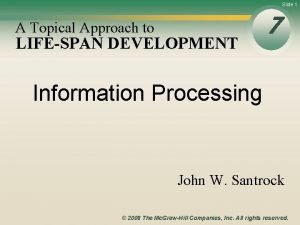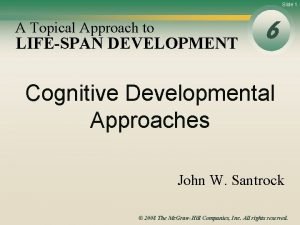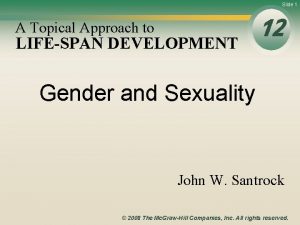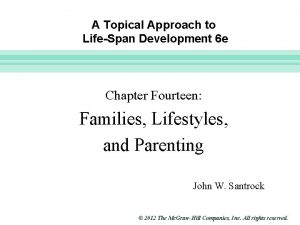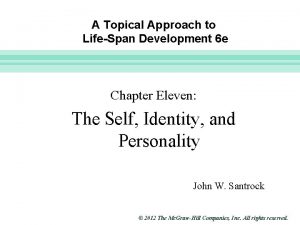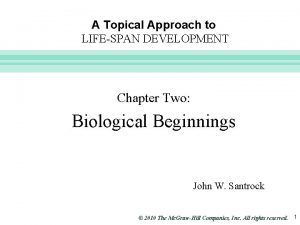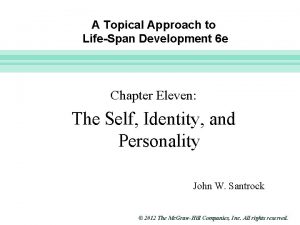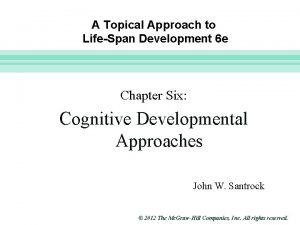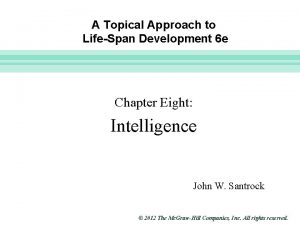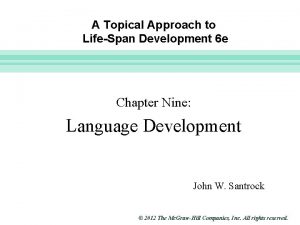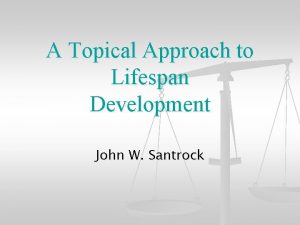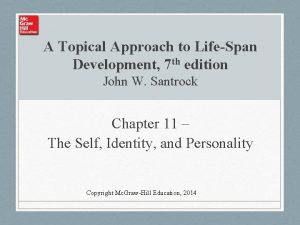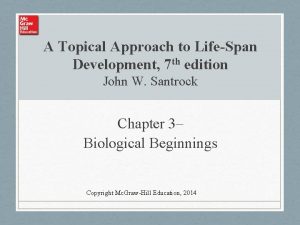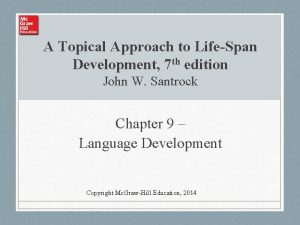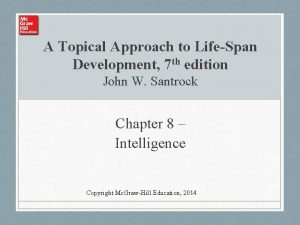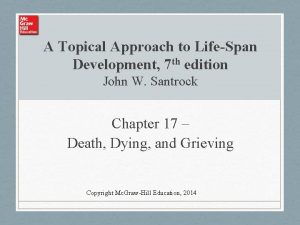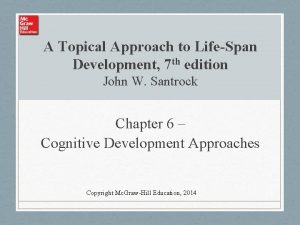Slide 1 A Topical Approach to LIFESPAN DEVELOPMENT



















































- Slides: 51

Slide 1 A Topical Approach to LIFE-SPAN DEVELOPMENT 3 Physical Development and Biological Aging John W. Santrock © 2008 The Mc. Graw-Hill Companies, Inc. All rights reserved.

Slide 2 Physical Development and Biological Aging • Body Growth and Change • The Brain • Sleep • Longevity © 2008 The Mc. Graw-Hill Companies, Inc. All rights reserved.

Slide 3 Body Growth and Change Patterns of Growth • Cephalocaudal pattern — growth occurs first at the top—the head—and gradually proceeds from top to bottom • Proximodistal pattern — growth starts at the center of the body and moves toward the extremities © 2008 The Mc. Graw-Hill Companies, Inc. All rights reserved.

Slide 4 Body Growth and Change Height and Weight in Infancy and Childhood Infancy • Average 20 inches, 7 ½ lbs at birth • Triple weight by 1 year • ½ adult height, 20% adult weight by age 2 Early Childhood • Growth slows, patterns vary individually • Girls slightly smaller and lighter • Girls gain fat, boys gain muscle Middle and Late Childhood • Slower, consistent growth • Muscle mass and strength increase • Boys stronger, body proportions change © 2008 The Mc. Graw-Hill Companies, Inc. All rights reserved.

Slide 5 Body Growth and Changes in Proportions of the Human Body During Growth Fig. 3. 1 © 2008 The Mc. Graw-Hill Companies, Inc. All rights reserved.

Slide 6 Body Growth and Change Height and Weight in Infancy and Childhood • Why some children are unusually short • Congenital factors • Growth hormone deficiency • Physical problem developed in childhood • Maternal smoking during pregnancy • Emotional difficulty © 2008 The Mc. Graw-Hill Companies, Inc. All rights reserved.

Slide 7 Body Growth and Change Determinants of Puberty • Heredity • Hormones – Hypothalamus, pituitary gland, gonads – Androgens (testosterone) – Estrogens (estradiol) – Thyroid gland growth effects – Cortisol may influence growth © 2008 The Mc. Graw-Hill Companies, Inc. All rights reserved.

Slide 8 Body Growth and Change Puberty • Period of rapid physical maturation involving hormonal and bodily changes that take place in early adolescence • Two phases: – Adrenarche — changes in adrenal glands – Gonardarche • Menarche • Spermarche • Weight and body fat © 2008 The Mc. Graw-Hill Companies, Inc. All rights reserved.

Body Growth and Change Slide 9 Hormone Levels by Sex and Pubertal Stage for Testosterone and Estadiol Fig. 3. 2 © 2008 The Mc. Graw-Hill Companies, Inc. All rights reserved.

Slide 10 Body Growth and Change Pubertal Growth Spurt Fig. 3. 3 © 2008 The Mc. Graw-Hill Companies, Inc. All rights reserved.

Slide 11 Normal Range and Average Development of Sexual Characteristics in Males and Females Fig. 3. 4 © 2008 The Mc. Graw-Hill Companies, Inc. All rights reserved.

Slide 12 Body Growth and Change Secular Trends in Puberty • Onset of puberty beginning earlier – Norway — menarche at 17 in 1840 s, now 13 – U. S. — menarche at 15 in 1840 s, now 12½ • White girls at average of 10 • African American girls at average 8 to 9 © 2008 The Mc. Graw-Hill Companies, Inc. All rights reserved.

Slide 13 Body Growth and Change Body Image in Puberty • Adolescents become preoccupied by bodies – Overall, girls less satisfied, boys more satisfied – Throughout puberty… • Girls’ dissatisfaction increases — body fat increases • Boys’ satisfaction increases — muscle mass increases © 2008 The Mc. Graw-Hill Companies, Inc. All rights reserved.

Slide 14 Body Growth and Change Body Image in Puberty • Early and Late Maturation – Early boys more positive, better peer relations – Late boys less positive but have more positive identity by 30 s than early boys © 2008 The Mc. Graw-Hill Companies, Inc. All rights reserved.

Slide 15 Body Growth and Change Body Image in Puberty • Early and Late Maturation – Early girls more at risk for problems • Smoking and drinking • Depression and eating disorders • Lower education and occupational attainment • Early dating and sexual experiences • Mental disorders and behavior problems © 2008 The Mc. Graw-Hill Companies, Inc. All rights reserved.

Slide 16 Body Growth and Change Early Adulthood • Physical changes may be subtle – Height is constant – Many reach peak of muscle tone and strength in late teens and twenties – Peak in joint functions in twenties – Decline in the thirties © 2008 The Mc. Graw-Hill Companies, Inc. All rights reserved.

Slide 17 Body Growth and Change Middle Adulthood • Physical – Lose height, gain weight – More skin wrinkling, sagging in 40 s and 50 s – Youth-oriented culture motivates life style changes • Strength, bone density, flexibility decrease – 1 to 2 percent loss each year after age 50 – Sarcopenia: age-related loss of muscle mass © 2008 The Mc. Graw-Hill Companies, Inc. All rights reserved.

Slide 18 Body Growth and Change Middle Adulthood • Cardiovascular system and lungs – HDL and LDL cholesterol, clogged arteries – Hypertension: blood pressure increases – Decreased lung capacity after age 55 • Sexuality changes – Climacteric — fertility declines – Menopause — menstrual periods cease © 2008 The Mc. Graw-Hill Companies, Inc. All rights reserved.

Body Growth and Change Slide 19 Lung Capacity, Smoking and Age Fig. 3. 5 © 2008 The Mc. Graw-Hill Companies, Inc. All rights reserved.

Slide 20 Body Growth and Change Late Adulthood • Variability in physical declines – Socioeconomic status is a big factor • Physical appearance – Wrinkles, age spots, height and weight loss – Weightlifting can slow process • Circulatory system – Increased blood pressure; linked to chronic conditions and longevity © 2008 The Mc. Graw-Hill Companies, Inc. All rights reserved.

Slide 21 The Brain Physiology • Structure and function – Forebrain – Cerebral cortex has four lobes • Two hemispheres usually work together and each lobe has a primary function • Frontal, occipital, temporal, parietal lobes – Amygdala – Hippocampus © 2008 The Mc. Graw-Hill Companies, Inc. All rights reserved.

The Brain Slide 22 The Brain’s Four Lobes Fig. 3. 7 © 2008 The Mc. Graw-Hill Companies, Inc. All rights reserved.

Slide 23 The Brain Functions of Lobes of the Cortex Frontal lobes Involved in voluntary movement, thinking, personality, and intentionality or purpose Occipital lobes Function in vision Active role in hearing, language Temporal lobes processing, and memory Parietal lobes Roles in registering spatial location, attention, and motor control © 2008 The Mc. Graw-Hill Companies, Inc. All rights reserved.

Slide 24 Development of the Brain • Can skip pages 107 -131 • By age 6, almost adult size. • Brain growth spurts: coincide with changes in cognitive behavior • Cerebellum, largest part of brain, divides into halves • Lateralization, specialties of each hemisphere; left: language and logical thinking; right: visual and spatial functions © 2008 The Mc. Graw-Hill Companies, Inc. All rights reserved.

Slide 25 © 2008 The Mc. Graw-Hill Companies, Inc. All rights reserved.

Slide 26 The Brain Physiology • Neurons — nerve cells handling information processing at the cellular level – – Axon, dendrites, synapses Neurotransmitters: dopamine Myelin sheath and myelination Neural circuits • Lateralization — specialization of functions in one hemisphere of cerebral cortex © 2008 The Mc. Graw-Hill Companies, Inc. All rights reserved.

Slide 27 The Brain The Neuron Fig. 3. 8 © 2008 The Mc. Graw-Hill Companies, Inc. All rights reserved.

Slide 28 The Brain In Infancy • Shaken Baby Syndrome • Extensive brain development in utero – Born with about 100 billion neurons – Enriched early experiences can enhance brain growth and functioning – Brain flexibility and resilience demonstrated in deprived environments • Experience determines brain connections – Enriched and deprived environments © 2008 The Mc. Graw-Hill Companies, Inc. All rights reserved.

Slide 29 The Brain In Infancy • Changing neurons – Myelination; visual and auditory – Rapid growth of myelin sheath, dendrite and synapse connections – Blooming and pruning of connections in brain – Peak synaptic overproduction influenced by heredity and environment © 2008 The Mc. Graw-Hill Companies, Inc. All rights reserved.

Slide 30 The Brain In Infancy • At birth, greater activity in left hemisphere specializes as infants listen to speech • Motor control begins about 2 months • Brain areas do not mature uniformly; skills affected by myelination and interconnections © 2008 The Mc. Graw-Hill Companies, Inc. All rights reserved.

Slide 31 The Brain Dendritic Spreading Fig. 3. 11 © 2008 The Mc. Graw-Hill Companies, Inc. All rights reserved.

Slide 32 Synaptic Density in Human Brain from Infancy to Adulthood Fig. 3. 12 © 2008 The Mc. Graw-Hill Companies, Inc. All rights reserved.

Slide 33 The Brain in Childhood • During early childhood, the brain and head grow more rapidly than any other part of the body — growth curves • Some of brain’s increase due to mylenation and some due to increase in number and size of dendrites • Greatest anatomical brain increases from ages 3 to 15 years © 2008 The Mc. Graw-Hill Companies, Inc. All rights reserved.

Slide 34 The Brain Growth Curves for Head and Brain and for Height and Weight Fig. 3. 13 © 2008 The Mc. Graw-Hill Companies, Inc. All rights reserved.

Slide 35 The Brain in Adolescence • Growth still occurs in adolescence – Corpus callosum: fiber bundle thickens – Prefrontal cortex grows: reasoning, selfcontrol, and decision making – Amygdala matures early: emotions and anger • Implications for adolescent behavior, legal system, and death penalty? © 2008 The Mc. Graw-Hill Companies, Inc. All rights reserved.

Slide 36 The Brain in Adolescence • Adolescent emotions — – Slow development of prefrontal cortex – Poor self-control; seek rewards and pleasure – Seek novelty; increased risk-taking – Lack of practical experiences; immature judgment © 2008 The Mc. Graw-Hill Companies, Inc. All rights reserved.

Slide 37 The Brain Adulthood and Aging • The Shrinking, Slowing Brain – Brain loss: 5 -10% of weight in ages 20 to 90 – Dendrites decrease; death of brain cells – Shrinkage of prefrontal cortex – General slowing of function in brain and spinal cord begins in middle adulthood and accelerates in late adulthood – Reductions in neurotransmitters © 2008 The Mc. Graw-Hill Companies, Inc. All rights reserved.

Slide 38 The Brain The Adapting Brain • Grows new brain cells throughout life – Extent depends on environment • Dendrite growth continues in adults • Brain rewires to compensate for losses • Less lateralization with age, more adaptation • Findings from Nun Study © 2008 The Mc. Graw-Hill Companies, Inc. All rights reserved.

Slide 39 Sleep in Infancy • Newborns average 16 -17 hours a day • Varied sleeping patterns – Longest sleep period: 11 pm to 7 am – May change from longer to shorter sleep periods – Most close to adult patterns by 4 months • More REM sleep than any other time of life • Shared sleeping with parents is controversial © 2008 The Mc. Graw-Hill Companies, Inc. All rights reserved.

Slide 40 Sleep Across the Human Life Span Fig. 3. 18 © 2008 The Mc. Graw-Hill Companies, Inc. All rights reserved.

Slide 41 Sleep SIDS • Infant stops breathing, usually during night, and suddenly dies without apparent cause • At highest risk – Having siblings who died of SIDS – African American and Eskimo infants – Lower SES groups – Passive exposure to cigarette smoke – Infants ages 4 to 6 wks – Sleeping on stomachs, use of soft bedding – Low birth weight; diagnosed with sleep apnea – Sleeping with pacifier © 2008 The Mc. Graw-Hill Companies, Inc. All rights reserved.

Slide 42 Sleep in Early Childhood • Most young children sleep through the night and have one daytime nap – Nightmares: frightening dreams are more common – Night Terrors: sudden arousal from sleep © 2008 The Mc. Graw-Hill Companies, Inc. All rights reserved.

Slide 43 Sleep in Adolescence • Many adolescents are not getting enough sleep; average 9½ hours when available – Like to stay up late, sleep late in mornings – Try to make up sleep debt on weekends • Biological clocks have hormonal shift – Melatonin production — about an hour later each day delays sleepiness at night © 2008 The Mc. Graw-Hill Companies, Inc. All rights reserved.

Slide 44 Sleep in Adolescence • Sleep deprivation and school performance – Grogginess and inattentiveness – Poor test performance – Discipline problems – Reports of illness and depression – Low self-esteem – Ineffective stress management, exercise, diet © 2008 The Mc. Graw-Hill Companies, Inc. All rights reserved.

Slide 45 Sleep Adulthood and Aging • Many adults don’t get enough sleep • Middle age may bring sleep problems – Wakeful periods at night, less deep sleep • Many older adults go to bed earlier at night and wake up earlier in the morning – Afternoon naps • Insomnia increases in late adulthood © 2008 The Mc. Graw-Hill Companies, Inc. All rights reserved.

Slide 46 Longevity Life Expectancy and Life Span • Life span — upper boundary of life, maximum number of years an individual can live; about 120 years of age • Life expectancy — number of years that an average person born in a particular year will probably live © 2008 The Mc. Graw-Hill Companies, Inc. All rights reserved.

Slide 47 Longevity Life Expectancy • Females average 80 years, 74 years for males • Gender differences influenced by biological factors – extra X for females • Life expectancy varies across countries • U. S. men more likely to die from leading causes of death • Associated with lifestyle and workplace stress © 2008 The Mc. Graw-Hill Companies, Inc. All rights reserved.

Slide 48 Longevity Centenarians • Numbers increasing; affected by – Genes, heredity, and family history – Women who have never married – Ability to cope successfully with stress – Education, health, and lifestyle – Individual personality • Highest ratio in Okinawa © 2008 The Mc. Graw-Hill Companies, Inc. All rights reserved.

Longevity Slide 49 Risks of Dying from Cancer in Okinawa, Japan, and the United States Fig. 3. 19 © 2008 The Mc. Graw-Hill Companies, Inc. All rights reserved.

Slide 50 Longevity Biological Theories of Aging Cellular Clock Theory Maximum times that human cells can divide is about 75 to 80 Free-Radical Theory People age because their cells’ metabolism produces unstable oxygen molecules (free radicals) Mitochondrial Theory Aging caused by decay of mitochondria; oxidative damage Hormonal Stress Theory Fig. 3. 20 Aging in body’s hormonal system can lower resistance to stress and increase likelihood of disease © 2008 The Mc. Graw-Hill Companies, Inc. All rights reserved.

Slide 51 3 The End © 2008 The Mc. Graw-Hill Companies, Inc. All rights reserved.
 A topical approach to lifespan development
A topical approach to lifespan development What is heel and toe polka
What is heel and toe polka Topical approach meaning
Topical approach meaning Topical approach definition
Topical approach definition Topical approach definition
Topical approach definition Development through the lifespan 6th edition
Development through the lifespan 6th edition Lifespan development a psychological perspective
Lifespan development a psychological perspective Openstax
Openstax Exploring lifespan development chapter 1
Exploring lifespan development chapter 1 Guidance counselling and lifespan development
Guidance counselling and lifespan development Lifespan development third edition
Lifespan development third edition Lifespan development third edition
Lifespan development third edition Exploring lifespan development chapter 1
Exploring lifespan development chapter 1 Bioecological approach
Bioecological approach Snow leopard life cycle for kids
Snow leopard life cycle for kids Pelikaaniankerias
Pelikaaniankerias Display caramelized petit fours
Display caramelized petit fours Splendour beetle
Splendour beetle Bee larvae stages
Bee larvae stages Ponce de leon nationality
Ponce de leon nationality Experiencing the lifespan 4th edition
Experiencing the lifespan 4th edition Henry hudson 2nd voyage
Henry hudson 2nd voyage Lifespan of every animal
Lifespan of every animal The developing person through the life span 9th edition
The developing person through the life span 9th edition Prairie dog adaptations
Prairie dog adaptations Autism lifespan
Autism lifespan Nutrition across life stages
Nutrition across life stages Longest lifespan
Longest lifespan Da vinci lifespan
Da vinci lifespan Lifespan irb
Lifespan irb Fun facts about henry hudson
Fun facts about henry hudson Portuguese man o' war lifespan
Portuguese man o' war lifespan Lifespan of platelets
Lifespan of platelets Nudibranch scientific name
Nudibranch scientific name Zebrafish lifespan
Zebrafish lifespan Sugar glider rejection kit
Sugar glider rejection kit Concept formation in lifespan psychology
Concept formation in lifespan psychology Galapagos turtle lifespan
Galapagos turtle lifespan Yoda lifespan
Yoda lifespan Mary quiceno md
Mary quiceno md Journey across the lifespan
Journey across the lifespan Lifespan corn snake
Lifespan corn snake Slide method factoring
Slide method factoring Review title examples
Review title examples Enema dosage form
Enema dosage form Water washable ointment base
Water washable ointment base Membrain
Membrain Syllabus types
Syllabus types Topical scope in research
Topical scope in research Medication administration 3 pretest
Medication administration 3 pretest Topical dosage forms
Topical dosage forms Content based syllabus example
Content based syllabus example
